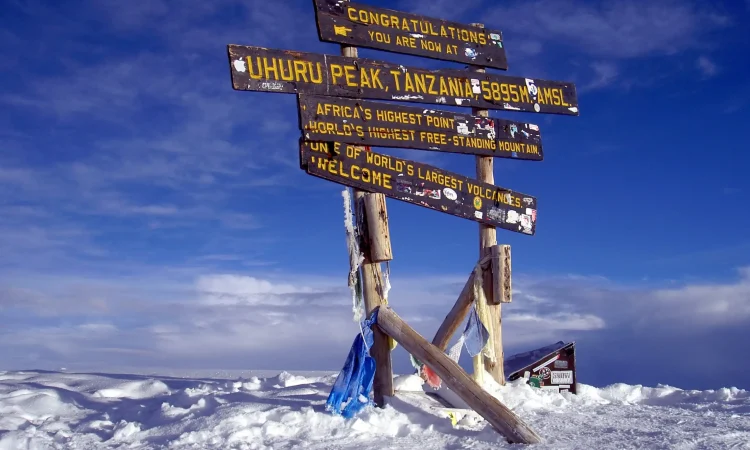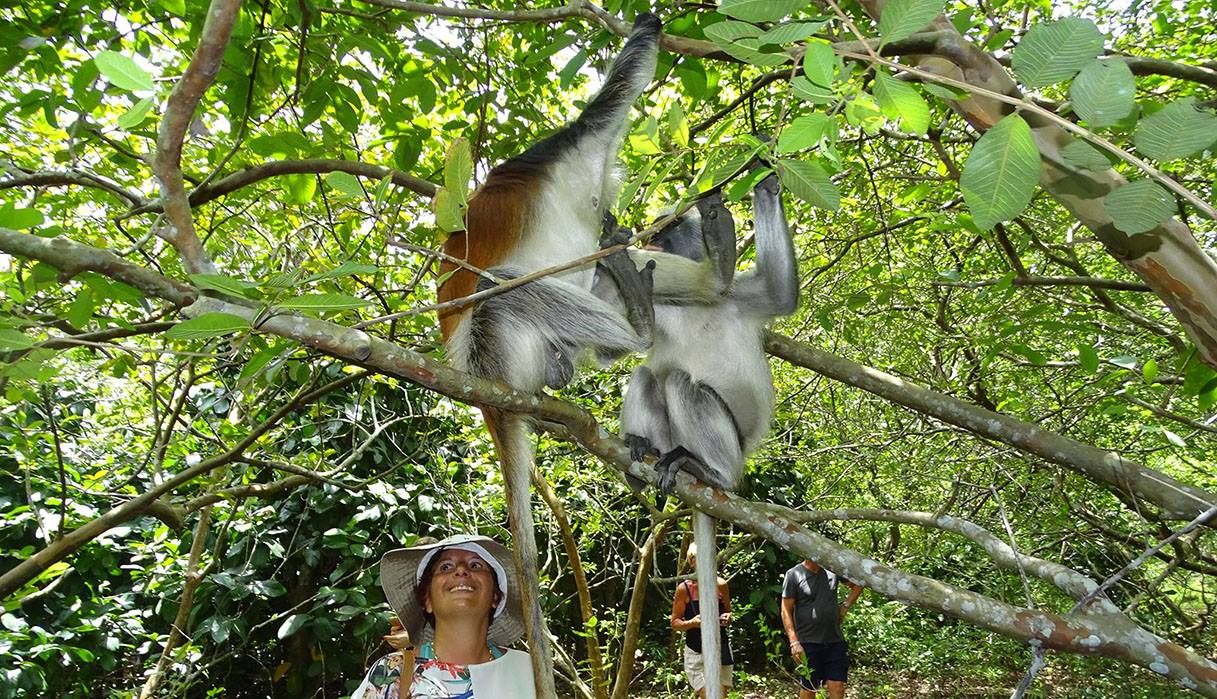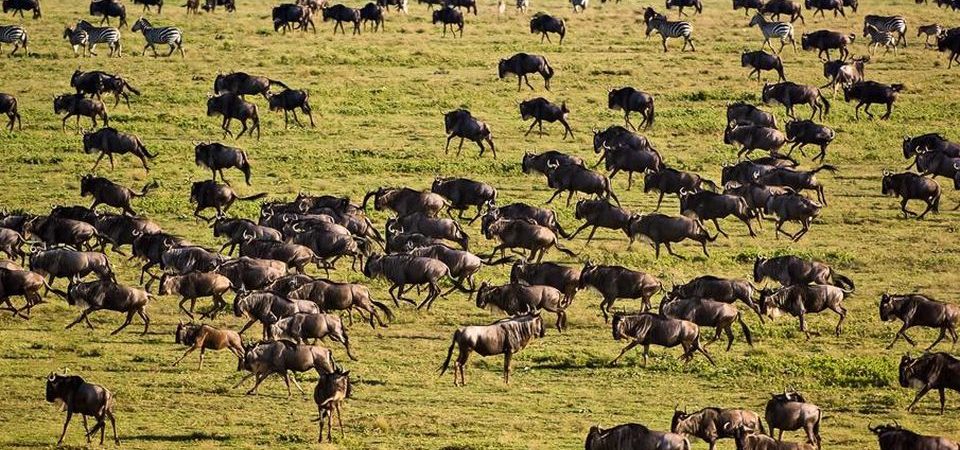Top Rated Natural Attractions in Tanzania : Tanzania’s natural attractions are not only a tourist draw to the East African region but also a dream destination for many people. Tanzania has a diverse range of natural environments, from huge wilderness areas to breathtaking seascapes. The islands of the Zanzibar archipelago offer a tropical paradise of exquisite proportions, while this phenomenal country is dotted with beautiful national parks that are among the best in Africa. We’ve compiled a few Natural Attractions lists since if I wrote them all, you’d be reading for the rest of the day. Let’s get right into it and see what we’ve got, Top Rated Natural Attractions in Tanzania .

Kilimanjaro, one of the world’s most iconic summits, draws trekkers from throughout the world who desire to reach its glacial peaks. With three volcanic cones, this inactive volcano holds the title of Africa’s tallest peak, rising to 5,895 meters above sea level (19,341 feet).
Day trips allow you to trek the mountain’s lower regions and see stunning scenery. Hikers with more experience can go on a longer trip, which lasts on average nine days. The dry seasons (January to mid-March and June to October) are the most popular since they provide better conditions and clearer prospects. Hire a tour operator (Focus East Africa Tour) to organize your hiking and make your hiking safari dream to roof of Africa come true. Make Kilimanjaro a part of your vacation itinerary as it is still one of Tanzania’s natural wonders.
Ngurdoto Crater
In the wetland at the bottom of Ngurdoto Crater, a volcanic crater in the heart of a forest, you may see herds of buffalo and other wild animals. This amazing 100-meter-deep crater has a diameter of 3.6 kilometers.
Steep cliffs were shaped when two volcanic cones combined and collapsed. Reds, black and white colobus monkeys, and blue monkeys are all to be seen. It’s worth noting that there’s no road to the crater and you can’t go into the swamp, but you may stand on the rim and observe. Make the Ngurdoto Crater the focal point of your Arusha trip itinerary and marvel at nature’s splendor.
Seronera
Seronera, a small town in the Serengeti National Park, serves as a hub for human and wildlife operations. The region is also on a significant migration route and serves as the starting point for many balloon safaris and park safaris, as well as a tiny airstrip for those arriving by plane. With amazing views of big cats hunting their prey around the borders of waterholes, you get a close-up look at the park’s life cycle.
The Ngorongoro Crater.
A natural wonder, a UNESCO World Heritage Site, and one of Tanzania’s most spectacular natural attractions. The nomadic Maasai tribe and a huge number of natural species find refuge in the Ngorongoro Crater.
The lush terrain of this massive volcanic crater, which is one of the world’s largest inactive calderas, occupies roughly 260 km2 of a nature reserve. Observe wildebeests, zebras, and one of the largest known groups of Maasai lions as you take in the limitless views and thickly inhabited highlands of the crater. Safaris are held in a strictly protected natural area and provide visitors with access to the crater, Top Rated Natural Attractions in Tanzania .
Jozani Forest
Take a close look at the uncommon red colobus monkey in Jozani Forest, Tanzania’s only national park on Zanzibar’s island. Dwarf frogs, Sykes monkeys, bush babies, Aders-duikers, and possibly the famous leopard of Zanzibar live in this 50-square-kilometer park with mangroves, tropical woods, and coral beaches.
More than 50 kinds of butterflies and 40 species of birds live alongside night hyraxes. Visit the red colobus, which represents Zanzibar’s conservation efforts, on a safari. One of Tanzania’s natural attractions.

The Grumeti River
The Serengeti National Park includes the Grumeti River, which serves as a safari region famed for big herbivores crossing rivers during large migrations. Among the many natural wild creatures in the region are Basque crocodiles, herds of hippos, zebras, buffaloes, lions, giraffes, and black and white colobus monkeys.
Although migration occurs from late May to early July, open-vehicle safaris are available all year. Small light planes are suitable for getting about the area, and there are several small airfields nearby. Include the Grumeti River in your Serengeti National Park customized itinerary to make your safari to Tanzania amazing and exception.
Mbudya Island
On Mbudya Island, unwind in the shade of lush foliage. An undeveloped island with white sand beaches and crystal-clear water, it is one of Tanzania’s natural beauties. The turquoise waters around the island are part of a marine reserve and provide excellent snorkeling opportunities with a variety of colorful species.
Several tiny hiking routes wind their way through lush woodlands, and you can stay longer at one of the campsites. There are no hotels or snack bars, but fresh-caught seafood and grilled lobsters are available on the beach. The island is reached via a 25-minute motorboat ride from a nearby fishing town, Top Rated Natural Attractions in Tanzania .
Ruaha National Park
Ruaha National Park, one of Africa’s largest parks, is known for its characteristic hilly scenery filled with exotic animals. Around 10,000 wandering elephants and 571 kinds of birds, including hornbills, kingfishers, and sunbirds, as well as white storks, reside on open grasslands covering 45,000 km2 and marshes covering 17,226 km2.
Take a Tanzania safari in the Ruaha Gorges to witness lions, leopards, giraffes, hippos, cheetahs, African wild dogs, lizards, cape buffaloes, and sand antelopes in their natural habitat. Large herbivores and predators frequent natural springs and rivers.
The Usambara Mountains.
Tanzania’s beautiful Usambara Mountains are located in the northeast. The Usambara Mountains are second to none as a natural attraction in Tanzania, with their expansive views, temperate climate, winding pathways, and lovely settlements. The Usambara Mountains are part of the old East African Archipelago, which stretches in a broken crescent from the Taita Hills in southern Kenya to Morogoro and the southern highlands.
They are thought to be at least 100 million years old, with the rocks that make them up to 600 million years old. The mountains are home to a diverse assortment of plants and animals, representing some of the continent’s highest biodiversity.
Cave Waterfall
At an altitude of 1940 meters on the slopes of Mount Meru in Arusha National Park, there is a magnificent and tranquil cave waterfall. It should be mentioned that when viewing the waterfall, certain rules must be followed, and travelers must be accompanied by either a travel expert or a tour guide, Top Rated Natural Attractions in Tanzania .
The source of the water is a river that originates from the mountain, and there is a large bathing hole at the bottom of the waterfall where tourists can swim under the supervision of tour operators or with a special authorization from Arusha National Park Authority. The hike to the waterfall is not difficult and is suitable for all ages.
Mount Meru
Mount Meru lies 80 kilometers west of Mount Kilimanjaro, in the middle of the Arusha National Park. Mount Meru, a large volcano with a height of 4,565 meters, stands out as one of Tanzania’s natural attractions. The hike to mount Meru is a great way to warm up for the mountain Kilimanjaro.
Due to the enormous number of wild animals that live on Mount Meru, hikers must climb with a ranger because the mountain is in Arusha National Park. Hikers are more likely to spot elephants, giraffes, and buffalo on the mountain’s lower slopes. The trail follows the northern edge of the volcano crater along a magnificent ridgeline as hikers continue their trek. The hiker’s lodging is designated in huts along the path throughout the ascent. Hikers reach the peak at sunrise for a breathtaking vista of Mount Kilimanjaro and the Mount Meru crater.
Ol Doinyo Lengai
Another volcano in the Maasai language is Ol Doinyo Lengai, which means “Mountain of God.” It is still an active volcano on the East African fault, rising to 2,962 meters in altitude. This one-of-a-kind mountain erupts with rare carbonatite lava. In the sun, lava appears black, brownish, or even silver-grey rather than blazing. It erupts at a lower temperature than other volcanoes, between 500 and 600 degrees Celsius (932–1112 degrees Fahrenheit).
Lava has a higher viscosity than “regular” lava and flows faster, but it is less viscous than water. When you watch it flow, it’s a fascinating sight. When the lava dries, it turns white in a matter of hours, producing a very distinctive environment that is not available anywhere else on the planet. The ash enriches the grasslands, allowing the annual wildebeest migration to take place. Year after year, thousands of calves call this place home.

Tarangire National Park.
Tarangire National Park is one of Tanzania’s most well-known parks, with over 700 lions, 450 bird species, and one of the world’s highest concentrations of elephants. The Tarangire ecosystem is one of Tanzania’s most vibrant and diverse. The park is also a lovely sight to behold, with a changing environment. The lush savannas give way to large green wetlands, and the environment is contaminated by massive termite mounds. Large herds of zebras and buffaloes benefit from the shade provided by giant baobab trees. During the dry season, these animals congregate along the Tarangire River’s banks. A visit to Tarangire National Park is highly recommended if you real wish to make your safari experience unforgettable.


